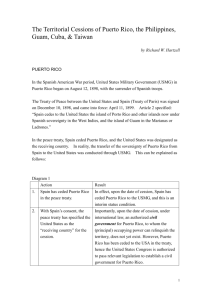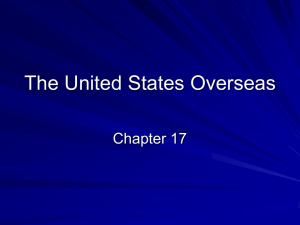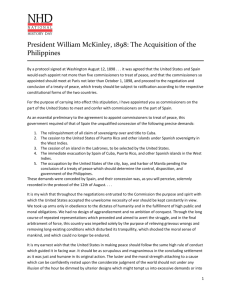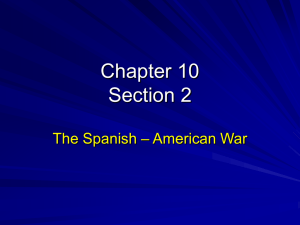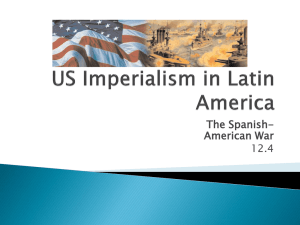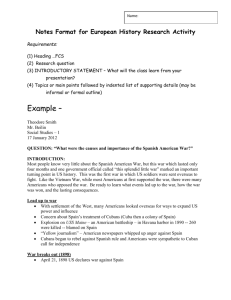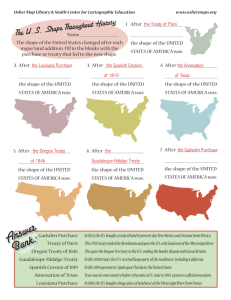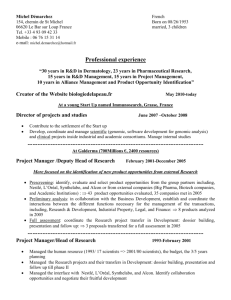The Territorial Cessions of Puerto Rico, the Philippines, Guam
advertisement
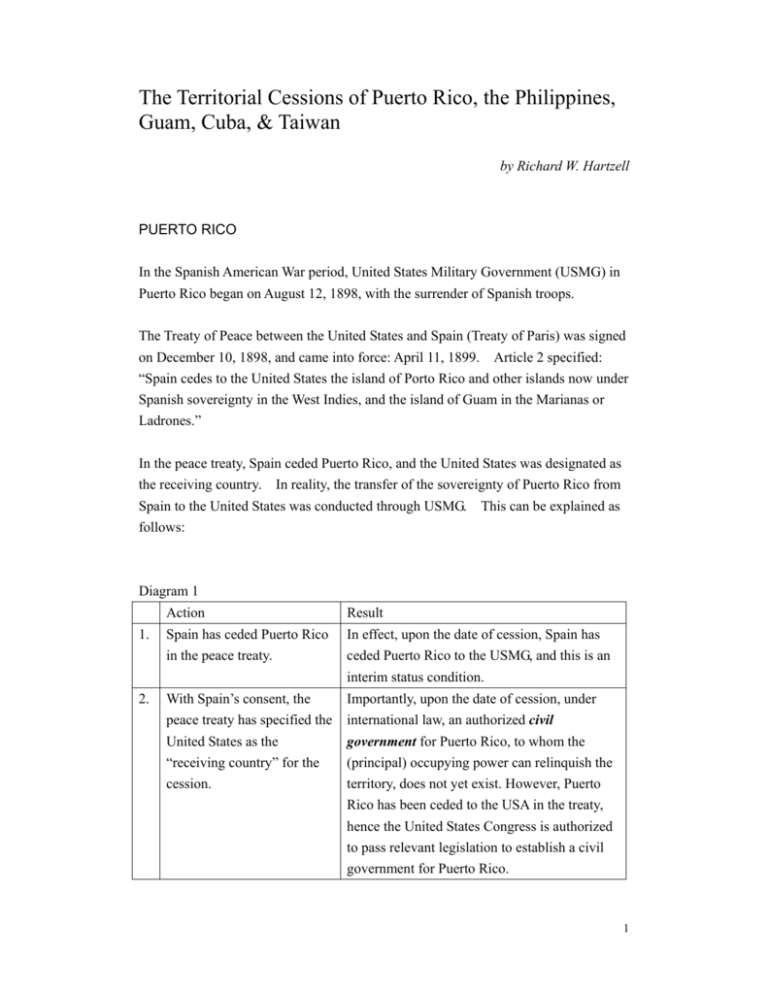
The Territorial Cessions of Puerto Rico, the Philippines, Guam, Cuba, & Taiwan by Richard W. Hartzell PUERTO RICO In the Spanish American War period, United States Military Government (USMG) in Puerto Rico began on August 12, 1898, with the surrender of Spanish troops. The Treaty of Peace between the United States and Spain (Treaty of Paris) was signed on December 10, 1898, and came into force: April 11, 1899. Article 2 specified: “Spain cedes to the United States the island of Porto Rico and other islands now under Spanish sovereignty in the West Indies, and the island of Guam in the Marianas or Ladrones.” In the peace treaty, Spain ceded Puerto Rico, and the United States was designated as the receiving country. In reality, the transfer of the sovereignty of Puerto Rico from Spain to the United States was conducted through USMG. This can be explained as follows: Diagram 1 1. 2. Action Result Spain has ceded Puerto Rico In effect, upon the date of cession, Spain has in the peace treaty. ceded Puerto Rico to the USMG, and this is an interim status condition. With Spain’s consent, the peace treaty has specified the United States as the “receiving country” for the Importantly, upon the date of cession, under cession. international law, an authorized civil government for Puerto Rico, to whom the (principal) occupying power can relinquish the territory, does not yet exist. However, Puerto Rico has been ceded to the USA in the treaty, hence the United States Congress is authorized to pass relevant legislation to establish a civil government for Puerto Rico. 1 Comments: Under USMG, the United States flag flew over Puerto Rico from August 12, 1898, until May 1, 1900. During this period, the allegiance of the local populace was to the United States. Since Puerto Rico was ceded to the USA in the post-war peace treaty, the United States flag continued to fly after the establishment of civil government operations in the territory. The populace continued to give allegiance to the United States. It is important to recognize that under the military government of the (principal) occupying power, Puerto Rico had not yet reached a final political status. During this period, Puerto Rico was in “interim status” under the law of occupation. This “interim status” condition continued until the military government of the (principal) occupying power was legally supplanted. THE PHILIPPINES In the Spanish American War period, United States Military Government (USMG) in the Philippines began on August 14, 1898, with the surrender of Spanish troops. The Treaty of Peace between the United States and Spain (Treaty of Paris) was signed on December 10, 1898, and came into force: April 11, 1899. Article 3 specified: “Spain cedes to the United States the archipelago known as the Philippine Islands ….” In the peace treaty, Spain ceded the Philippines, and the United States was designated as the receiving country. In reality, the transfer of the sovereignty of the Philippines from Spain to the United States was conducted through USMG. This can be explained as follows: Diagram 2 Action Result 1. Spain has ceded the Philippines in the peace treaty. In effect, upon the date of cession, Spain has ceded the Philippines to the USMG, and this is an interim status condition. 2. With Spain’s consent, the peace treaty has specified the Importantly, upon the date of cession, under international law, an authorized civil 2 United States as the “receiving country” for the government for the Philippines, to whom the (principal) occupying power can relinquish the cession. territory, does not yet exist. However, the Philippines has been ceded to the USA in the treaty, hence the United States Congress is authorized to pass relevant legislation to establish a civil government for the Philippines. Comments: Under USMG, the United States flag flew over the Philippines from August 14, 1898, until July 4, 1901. During this period, the allegiance of the local populace was to the United States. Since The Philippines was ceded to the USA in the post-war peace treaty, the United States flag continued to fly after the establishment of civil government operations in the territory. The populace continued to give allegiance to the United States. It is important to recognize that under the military government of the (principal) occupying power, the Philippines had not yet reached a final political status. During this period, the Philippines was in “interim status” under the law of occupation. This “interim status” condition continued until the military government of the (principal) occupying power was legally supplanted. GUAM In the Spanish American War period, United States Military Government (USMG) in Guam began on June 21, 1898, with the surrender of Spanish troops. The Treaty of Peace between the United States and Spain (Treaty of Paris) was signed on December 10, 1898, and came into force: April 11, 1899. Article 2 specified: “Spain cedes to the United States the island of Porto Rico and other islands now under Spanish sovereignty in the West Indies, and the island of Guam in the Marianas or Ladrones.” In the peace treaty, Spain ceded Guam, and the United States was designated as the receiving country. In reality, the transfer of the sovereignty of Guam from Spain to the United States was conducted through USMG. This can be explained as follows: 3 Diagram 3 1. 2. Action Result Spain has ceded Guam in the In effect, upon the date of cession, Spain has peace treaty. ceded Guam to the USMG, and this is an interim status condition. With Spain’s consent, the peace treaty has specified the United States as the “receiving country” for the Importantly, upon the date of cession, under cession. international law, an authorized civil government for Guam, to whom the (principal) occupying power can relinquish the territory, does not yet exist. However, Guam has been ceded to the USA in the treaty, hence the United States Congress is authorized to pass relevant legislation to establish a civil government for Guam. Comments: Under USMG, the United States flag flew over Guam from June 21, 1898, until July 1, 1950. During this period, the allegiance of the local populace was to the United States. Since Guam was ceded to the USA in the post-war peace treaty, the United States flag continued to fly after the establishment of civil government operations in the territory. The populace continued to give allegiance to the United States. It is important to recognize that under the military government of the (principal) occupying power, Guam had not yet reached a final political status. During this period, Guam was in “interim status” under the law of occupation. This “interim status” condition continued until the military government of the (principal) occupying power was legally supplanted. CUBA In the Spanish American War period, United States Military Government (USMG) in Cuba began on July 17, 1898, with the surrender of Spanish troops. The Treaty of Peace between the United States and Spain (Treaty of Paris) was signed 4 on December 10, 1898, and came into force: April 11, 1899. Article 1 specified: “Spain relinquishes all claim of sovereignty over and title to Cuba. And as the island is, upon its evacuation by Spain, to be occupied by the United States, the United States will, so long as such occupation shall last, assume and discharge the obligations that may under international law result from the fact of its occupation, for the protection of life and property.” In the peace treaty, Spain ceded Cuba, but no receiving country was designated. This is a “limbo cession.” In reality, the transfer of the sovereignty of Cuba from Spain to the Republic of Cuba was conducted through USMG. This can be explained as follows: Diagram 4 1. 2. Action Result Spain has ceded Cuba in the In effect, upon the date of cession, Spain has peace treaty. ceded Cuba to the “United States Military Government,” and this is an interim status condition. After consideration by all relevant parties, no agreement was reached to specify any Importantly, upon the date of cession, under other country as the “receiving country” for the cession. Hence, none is stipulated. international law, an authorized civil government for Cuba, to whom the (principal) occupying power can relinquish the territory, does not yet exist. Moreover, no country has been authorized to pass relevant legislation to establish a civil government for Cuba. Cuba remains under “United States Military Government” until USMG is legally supplanted. Comments: Under USMG, the United States flag flew over Cuba from July 17, 1898, until May 20, 1902. During this period, the allegiance of the local populace was to the United States. The Republic of Cuba began civil government operations on May 20, 1902, so on that day the United States flag came down, and the Republic of Cuba flag went up. The populace then gave allegiance to the Republic of Cuba. It is important to recognize that under the military government of the (principal) 5 occupying power, Cuba had not yet reached a final political status. During this period, Cuba was in “interim status” under the law of occupation. This “interim status” condition continued until the military government of the (principal) occupying power was legally supplanted. TAIWAN In the WWII period, after the end of military battles in the Pacific, United States Military Government (USMG) in “Formosa and the Pescadores” (hereinafter “Taiwan”) began on October 25, 1945, with the surrender of Japanese troops. USMG delegated the administration of this area to the Chinese Nationalists by means of the “law of agency.” It is important to recognize that the administration of this area was handled separately from the administration of the four main Japanese islands. Notes: The law of agency is the body of legal rules and norms concerned with any principal – agent relationship, in which one person (or group) has legal authority to act for another. The law of agency is based on the Latin maxim "Qui facit per alium, facit per se," which means "he who acts through another is deemed in law to do it himself." The Treaty of Peace with Japan (San Francisco Peace Treaty) was signed on September 8, 1951, and came into force April 28, 1952. The following Articles are important. Article 2(b): Japan renounces all right, title and claim to Formosa and the Pescadores. Article 4(b): Japan recognizes the validity of dispositions of property of Japan and Japanese nationals made by or pursuant to directives of the United States Military Government in any of the areas referred to in Articles 2 and 3. Article 23: . . . . . including the United States of America as the principal occupying Power, . . . . . In the peace treaty, Japan ceded “Formosa and the Pescadores,” but no receiving country was designated. This is a “limbo cession.” An analysis of the transfer of the sovereignty of Taiwan from Japan to the PRC through USMG is provided as follows. (Note: As of 2006, this transfer has not yet been completed.) 6 Diagram 5 1. Action Result Japan has ceded Taiwan in the peace treaty. In effect, upon the date of cession, Japan has ceded Taiwan to the “United States Military Government,” and this is an interim status condition. 2. After consideration by all relevant parties, no agreement was reached to specify any other country as the “receiving country” for the Importantly, upon the date of cession, under international law, an authorized cession. Hence, none is stipulated. the territory, does not yet exist. Moreover, no country has been authorized to pass relevant legislation to establish a civil government for Taiwan. Taiwan remains civil government for Taiwan, to whom the principal occupying power can relinquish under “United States Military Government” until USMG is legally supplanted. Comments: Under USMG, the United States flag should be flying over Taiwan as of April 28, 1952, (if not earlier). The allegiance of the local populace is to the United States. It is important to recognize that under the military government of the (principal) occupying power, Taiwan has not yet reached a final political status. During this period, Taiwan is in “interim status” under the law of occupation. This “interim status” condition continues until the military government of the principal occupying power is legally supplanted. In other words, according to the examples provided above in regard to Puerto Rico, the Philippines, Guam, and Cuba, it is clear that the military government of the principal occupying power does not end upon the coming into force of the peace treaty, but continues until legally supplanted. To date, USMG administrative authority over Taiwan is still active. Shanghai Communiqué The following wording in the February 28, 1972, communiqué is important: The U.S. side declared: The United States acknowledges that all Chinese on either side of the Taiwan Strait maintain there is but one China and that Taiwan is a part of China. The United States Government does not challenge that position. It reaffirms 7 its interest in a peaceful settlement of the Taiwan question by the Chinese themselves. With this prospect in mind, it affirms the ultimate objective of the withdrawal of all U.S. forces and military installations from Taiwan. In the meantime, it will progressively reduce its forces and military installations on Taiwan as the tension in the area diminishes. In the Shanghai Communiqué, the United States has established the One China Policy, and has made arrangements for the final disposition of Taiwan, in accordance with SFPT Article 4(b). However, during the period of “interim status,” Taiwan is entitled to fundamental rights under the US Constitution. For the territory, these fundamental rights include the Article 1, Section 8 stipulation that Congress will provide for the “common defense.” For the people, these fundamental rights include life, liberty, property, and due process of law under the Fifth Amendment. Unfortunately, these rights have been denied for over fifty years. Additionally, with no US High Commission established in Taiwan, the Taiwanese people have even been denied the right to petition the Government for a redress of grievances. CUBA & TAIWAN A closer examination of the situations of Cuba (according to the Treaty of Paris) and Taiwan (according to the San Francisco Peace Treaty) may be made as follows: Diagram 6 Item United States is the (principal) Treaty of Paris SFPT specifications for specifications for Cuba Taiwan Article 1 Article 23 Article 1 Article 2(b) Article 1 Article 2(b) Article 1 Article 4(b) Article 1 Article 4(b) and the Hague occupying power Original “owner” did indeed cede the territory No “receiving country” was specified (i.e. “limbo cession”) USMG has disposition rights over the territory Military government is present, and military occupation is a reality Conventions (1907) 8
